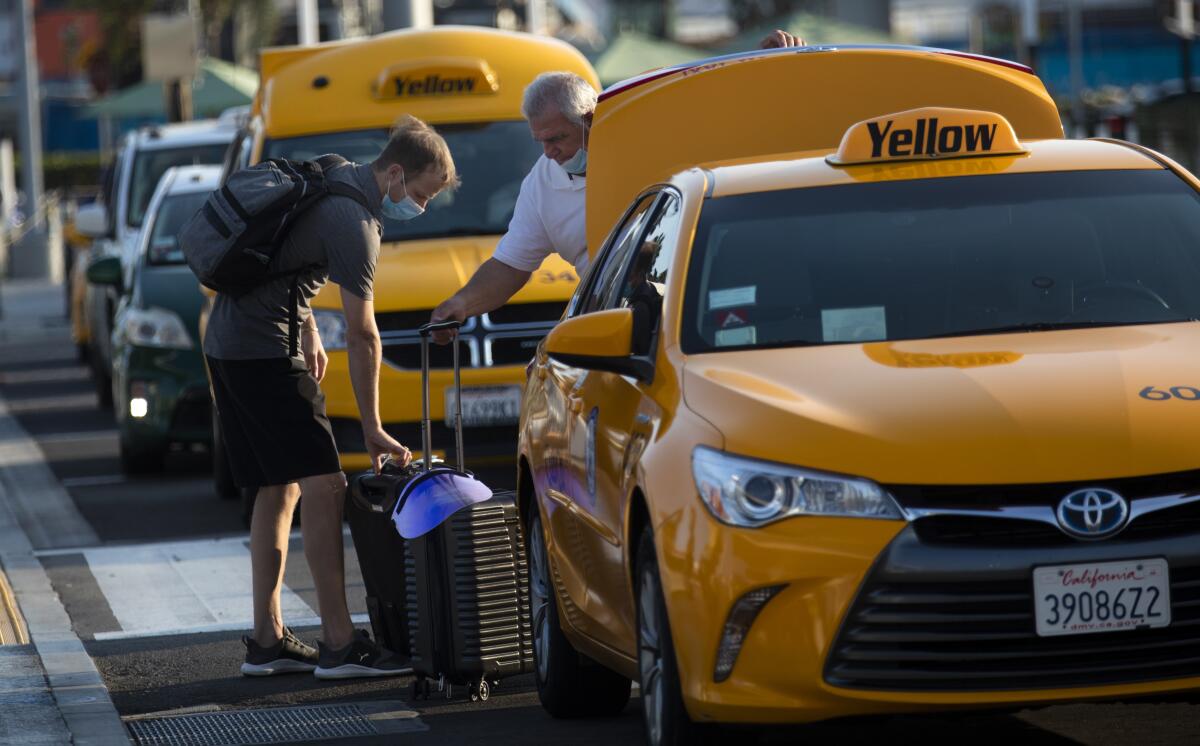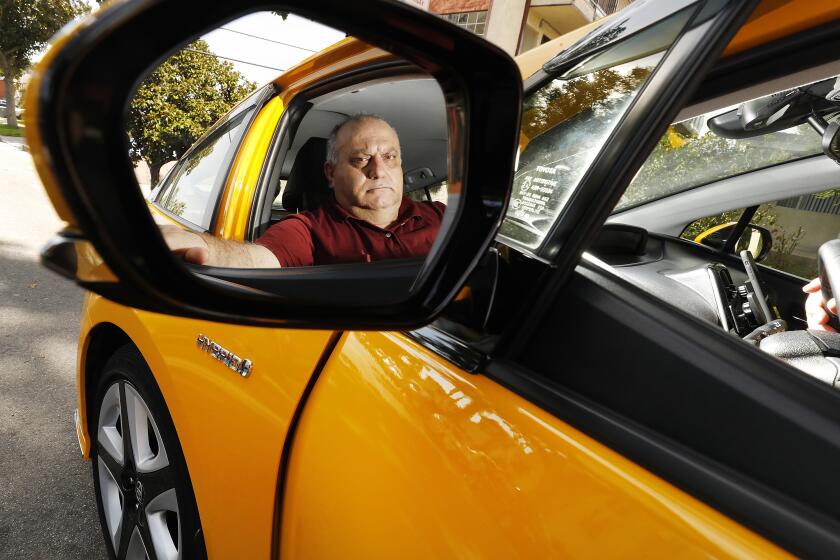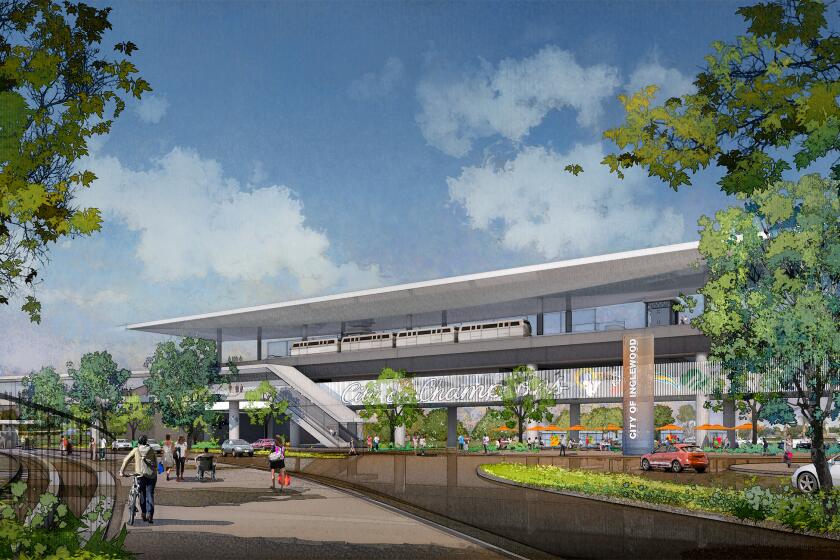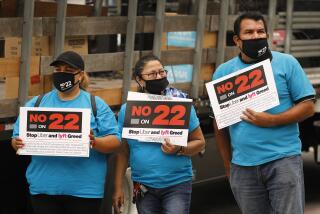Can L.A. save its taxi industry? It’s trying to with new apps, more permits

- Share via
Uber arrived in Los Angeles a decade ago, and along with Lyft and other competitors brought the region’s taxi industry to its knees.
Competing against the venture capital-funded apps, taxi companies shrank or went out of business and drivers left in droves. As the small industry grappled to find new technology, it also blamed regulators for besetting it with rules the new companies evaded.
On Tuesday, the Los Angeles City Council threw the taxi industry a lifeline. The council unanimously approved an ordinance that overhauls the city-regulated franchise system and gives approved ride-hailing applications access to traffic and other city data intended to make dispatching drivers more efficient.
“This is designed to basically make the taxi companies competitive in the modern world,” said Eric Spiegelman, president of the city’s Taxi Commission. “To the regular Angeleno, I hope they are going to see taxis as something integral into how they get around town in a way that Uber and Lyft were for the last couple of years.”
In addition to digital upgrades, the overhaul allowed for cosmetic changes: Taxis will no longer have to be painted bright yellow or other colors and won’t be required to be plastered with signage. Instead, the vehicles will bear a decal.
As Lyft and Uber gain ridership, taxi drivers don’t see a future.
The city also will no longer cap the number of authorized cabs receiving a 10-year permit to operate. Until now, the industry has been limited to 2,364 permits. Los Angeles officials will monitor how well the system is working, analyzing driver wages, fleet size, wait times and ride frequency every time the permits increase by 5,000.
Riders will now be able to access taxis on cellphone apps similar to Uber and Lyft that provide fare amounts up front. The platforms are run by companies such as Curb and Flywheel, with certain data collected from the Los Angeles Department of Transportation.
City officials say the sharing of data will allow them to better analyze rider demands and fares. But the arrangement has rankled privacy advocates who are concerned that riders’ information could be shared. A case brought by the ACLU of Southern California to stop the use of the software is on appeal at the U.S. 9th Circuit Court of Appeals, after the court ruled in the city’s favor.
“I wish this could have happened earlier,” said Yevgeny Smolyar, the former president of Checker Cab, which closed in 2020. “But it might be the right time now. Uber and Lyft are charging more money and they have less cars.”
An Uber spokesperson declined to comment on the city’s action. Lyft did not respond to a request for comment.
For the record:
7:47 a.m. Feb. 16, 2022A previous version of this article reported that ride-hailing fares increased by as much as 27% in Los Angeles in the first quarter of 2021. The increase was in the fourth quarter.
Ride-hailing fares had increased by as much as 27% in Los Angeles in the fourth quarter of 2021 compared with the same period in 2019, according to research firm YipitData.
The pandemic pummeled ride-hailing services and cab companies alike. At its lowest point only about 500 cabs were operating in the city; even now only about 1,300 are on the streets,
But as people get back to work and the economy opens up, officials hope to see those numbers rise.
“We think that with these changes, customers will go look at their Uber app and look at their Lyft app, and then they’re gonna begin to look at taxis as well. So taxis are going to start to be a viable third option,” said Jarvis Murray, a transportation administrator for the city who regulates taxis and scooters.
The rules that take effect next month will let Uber drivers or those working for another ride-hailing app easily join a cab company. Most of those operate as cooperatives and taxi permits must be obtained through them.
Spiegelman argues the advantage to taxis is that regulation requires more stringent background checks. And unlike Uber or Lyft, a certain number of cars in a company fleet must have wheelchair accessibility and be deployed to traditionally underserved neighborhoods. Critics have said that wait times in those communities have been much longer than those in well-heeled neighborhoods.
When Uber arrived, the taxi industry was ill-prepared for the disruptive rival: It lacked both the technology and the cars. Spiegelman said at one point there were 40,000 drivers for app-based services in Los Angeles, while the city capped the taxi permits.
Inglewood Mayor James T. Butts Jr. has proposed building a 1.8-mile people mover to connect SoFi Stadium, this year’s Super Bowl site, with the Crenshaw light rail line.
Opening up the permitting system to allow thousands more drivers on the road could make taxis more readily available.
But it could also depress driver wages, according to Victor Narro, the director of the UCLA Labor Center, and Bradan Litzinger, a UCLA law student, who made that argument in a report to the city in August.
Unlike Uber and Lyft, which could heavily subsidize rides, the mostly independent contractors who work as taxi drivers would wind up losing wages because small taxi companies couldn’t support them, Narro and Litzinger wrote.
William Rouse, chief executive of Yellow Cab of Los Angeles and United Checker Cab, says Uber and Lyft have shown there are more customers out there than people thought. He recalled how Uber upended things when it arrived.
On Friday and Saturday nights, the taxi company would have about 2,000 calls for service and not enough drivers. Uber plucked customers at cut rates as it began to upend the industry and change how urbanites think of transportation.
“Those weren’t good days for me,” he said. “Now we don’t get to blame the regulator anymore and now we have to fix what’s broken in our industry. ... The ball is in our court.”
More to Read
Sign up for Essential California
The most important California stories and recommendations in your inbox every morning.
You may occasionally receive promotional content from the Los Angeles Times.













